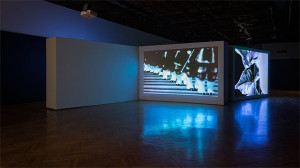In The Shape of a Pocket, the Mills College Art Museum brings together an exhibition of two artists whose work is by turns intangible and substantial. Fittingly, the process of wandering through the MCAM installation is akin to the private action of feeling out the edges of an unknown space. The same is true for the sensation of experiencing both Anne Colvin and Margaret Tait’s work. Using found and original footage, experimental techniques and minimal narrative, Colvin and Tait create insular and all-encompassing worlds without bound. Inside these “pockets” are even more discoveries — two remarkable artists, one working in the legacy of the other, and a multitude of beauty to be absorbed within the exhibition, given the patience and time to truly do so.
In the meditative darkness of the gallery, Colvin’s three-channel video installation A Granite Note is a large physical presence (projected on three 10 by 16-foot walls), but the imagery it depicts is fragmented, out of focus, or too close to absorb, remaining obscure and unknown despite its immense parts. While Tait’s Portrait of Ga and Colour Poems are given a smaller stage in a screening room, they are not afterthoughts to Colvin’s installation. Brief, atmospheric, and sometimes funny, Tait’s films require an enclosed, semi-private (and seated) viewing experience.
Scale is in constant flux in both Colvin and Tait’s works. While one portion of A Granite Note is visible upon opening the gallery door, the other two projections are angled towards the two closest walls, preventing viewers from ever observing the entire frame — you simply can’t get far enough away. The video facing the entrance shows marching bagpipers’ feet, their kilts swishing in slow motion and regular speed while a pleasant shimmering sound loops overhead.
On Colvin’s right wall, grainy high contrast flowers, their petals nearly 8 feet tall, move side to side, shifting in hue from lavender to peach to yellow. On the left wall, large boats move across the frame, cutting to choppy water and back again. The slight sound of crashing wave, possibly imagined, blends with a series of pleasant tones and the bagpipers’ shimmer.

Anne Colvin, A Granite Note installation view, 2014; Photo: Phil Bond
Anne Colvin, A Granite Note detail, 2014; Photo: Phil BondBehind the walls, red spotlights beam down on four paper sculptures. For these, Colvin sourced turn-of-the-century Scottish landscapes, printed them large-scale (halftone dots create a different type of rocky texture), then folded and shaped the paper to resemble rocks onces again.


